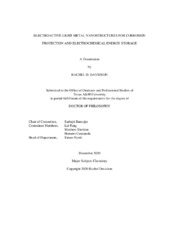| dc.description.abstract | Stability in electrochemical systems is governed by interactions at the local scale where isolated inhomogeneities can define system performance. This concept plays a key role in failure of battery systems and corrosion of materials. For rechargeable batteries, replacement of graphite with metal anodes provides considerable promise for sizable gains in gravimetric and volumetric energy densities. However, out of equilibrium processes guide formation of anisotropic, dendritic growths which are capable of short circuiting the cell and causing catastrophic failure of the system. Magnesium-based batteries have garnered significant interest as an alternative to lithium-ion largely due to its designation as a ‘dendrite free’ system.
This would allow for the use of metal anodes providing significant improvements in capacity compared to graphite but requires controlled and consistent plating and stripping of the active metal over hundreds of cycles. Here, we detail our investigations into the electrodeposition of magnesium in varying electric fields, electrolyte concentrations, and with the addition of growth-directing ligands, providing understanding of mechanisms of deposition across a wide range of deposit morphologies. Through combining in situ video microscopy studies of electrodeposition of Mg in symmetric cells with 3D tomographic characterization and mesoscale modeling we demonstrate some of the first definitive examples of dendritic growth on magnesium anodes and elucidate mechanisms of formation.
In corroding systems, local inhomogeneities often serve as key sites in failure, often dominating electrochemical activity. For corrosion inhibition, our approach has involved modular design of nanocomposite coatings enabling multiple modes of corrosion protection. Here we outline our efforts in design of magnesium nanoparticle and exfoliated graphite-based nanocomposites for protection of high-strength aluminum alloys. Mechanisms of corrosion inhibition have been elucidated through extended submersion testing coupled with electrochemical impedance spectroscopy measurements. | en |


